Transgender confusion is a growing epidemic, especially among minor children who could be manipulated by profit seeking agencies like Planned Parenthood and others. Planned Parenthood openly promotes this to minors and is among the organizations praising legislation seeking to codify access to transgender services by shielding those providers — much like they did for abortion. In addition, abortion facilities across the United States are also cashing in on the proliferation of transgender confusion, with some openly advertising “gender-affirming” services to minors.
Today, the number of young people accessing transgender services is on the rise, which might explain why a growing number of parents are addressing the transgender agenda and pressuring states to pass legislation to protect minor children.
General Statistics
In 2022, the Williams Institute claimed that roughly 1.4% of transgender-identifying individuals (about 300,000 youth) are between the ages of 13 to 17 in the U.S. The report found that young teens are a growing demographic of the transgender community, writing that “Youth ages 13 to 17 comprise a larger share of the transgender-identified population than…previously estimated, currently comprising about 18% of the transgender-identified population in the U.S., up from 10% previously.”
The Human Rights Campaign (HRC) claims online that, “there are more than 300,000 high school-aged (ages 13-17) transgender youth in the United States today.” Adding that many “trans youth (45.4%, or 136,300) live in states in which transgender youth have lost access to, or are at risk of losing access to, gender-affirming care.” In addition, HRC claimed “Three in ten (35.1% or 105,200 total) trans youth aged 13-17 live in states that have passed bans on gender affirming care.”
It should be noted, however, that this “care” is not restricted for adults.
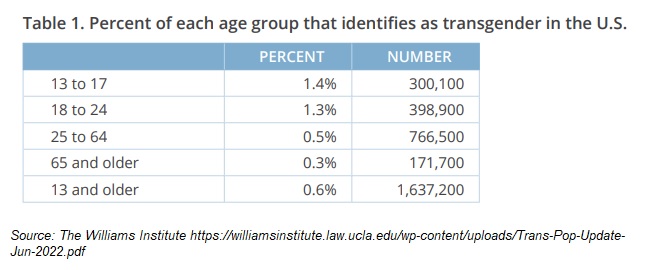
Trans identifying adults and youth The Williams Institute (June 2022)
“In 2021, about 42,000 children and teens across the United States received a diagnosis of gender dysphoria, nearly triple the number in 2017,” according to data Komodo [Health] compiled for Reuters. This represents a 64% increase from the 15,172 reported in 2017 and a 70% increase between just 2020 (24,847) and 2021 (42,167).
“Gender dysphoria is defined as the distress caused by a discrepancy between a person’s gender identity and the one assigned to them at birth,” Reuters reported.
“Komodo’s analysis draws on full or partial health insurance claims for about 330 million U.S. patients over the five years from 2017 to 2021, including patients covered by private health plans and public insurance like Medicaid. The data include roughly 40 million patients annually, ages 6 through 17, and comprise health insurance claims that document diagnoses and procedures administered by U.S. clinicians and facilities,” Reuters added.
“Overall, the [Komodo] analysis found that at least 121,882 children ages 6 to 17 were diagnosed with gender dysphoria from 2017 through 2021. Reuters found similar trends when it requested state-level data on diagnoses among children covered by Medicaid, the public insurance program for lower-income families,” Reuters wrote.
Things like “puberty blockers,” hormones, and surgery used among children with gender dysphoria have not been well studied.
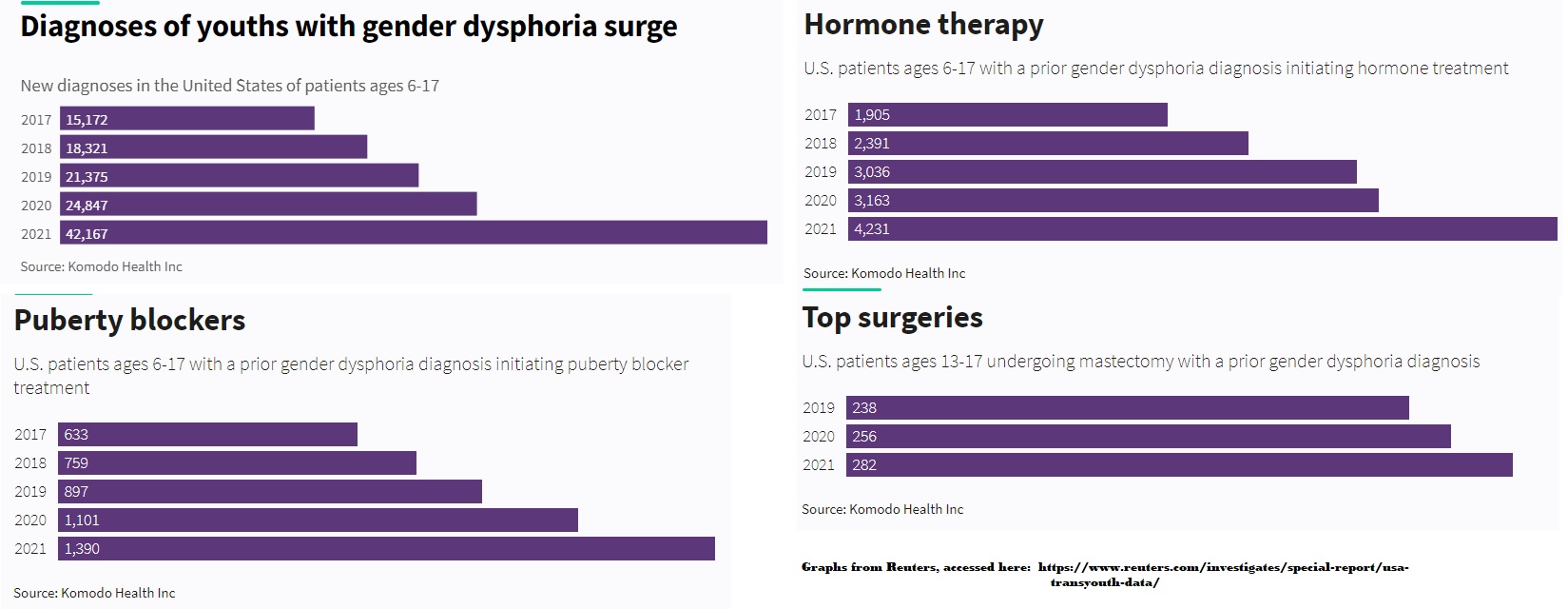
Adolescent youth: puberty blockers, hormone therapy, and top surgery GAC care (Graphs Per Reuters)
Use of Drugs Referred to as “Puberty Blockers”
Children diagnosed with gender dysphoria can begin medical interventions such as “puberty-blocking medications,” claimed Reuters, but these experimental drugs for children identifying as transgender do not begin until the onset of puberty. Blockers, as they are called, are actually drugs that were formerly used in the chemical castration of violent rapists. They work by suppressing estrogen and testosterone.
“Before puberty, neither the Endocrine Society, American Academy of Pediatrics, nor the World Professional Association for Transgender Health recommend any hormonal or surgical interventions,” HealthNews Florida reported.
According to the NYT, “They were first tested on children with gender dysphoria in the Netherlands in the 1990s. The Dutch researchers published their first study on 70 children in 2011,” NYT claimed. The study claimed adolescents reported a decrease in depression and anxiety after taking the drugs.
“But a British study of Tavistock patients published in 2021 showed that blockers had no effect on children’s scores on psychological tests,” NYT added.
According to Abigail Shrier, a journalist and author of the 2020 book, “Irreversible Damage: The Transgender Craze Seducing Our Daughters,” as “Dutch researchers were beginning to raise concerns about puberty blockers, American health providers discovered it. In 2007, the Dutch Protocol arrived at Boston Children’s Hospital, one of the preeminent children’s hospitals in the nation. It would soon become the leading course of treatment for all transgender-identified children and adolescents in the United States.”
“These drugs, known as GnRH agonists suppress the release of the sex hormones testosterone and estrogen. The U.S. Food and Drug Administration has approved the drugs [in 1985] to treat prostate cancer, endometriosis and central precocious puberty, but not gender dysphoria. Their off-label use in gender-affirming care, while legal, lacks the support of clinical trials to establish their safety for such treatment,” Reuters wrote.
And yet, even the abortion industry — which objects to the off-label use of the hormone progesterone to counteract the effects of the abortion pill (often referred to as “abortion pill reversal”), supports and participates in the administration of unstudied sex hormones to trans-identifying children.
“Over the last five years, there were at least 4,780 adolescents who started on puberty blockers and had a prior gender dysphoria diagnosis,” Reuters wrote. The numbers are likely undercounted, Reuters claimed, because “they didn’t include treatment that wasn’t covered by insurance and were limited to pediatric patients with a gender dysphoria diagnosis.”
Komodo’s data for Reuters indicates that the number of adolescents put on “puberty blockers” increased over 119% from 633 in 2017 to 1,390 in 2021.
Recently, the National Health Service of England announced “it would limit the use of puberty-suppressing drugs to children enrolled in clinical trials… A document explaining the agency’s reasoning stated that ‘there is not enough evidence to support their safety or clinical effectiveness as a routinely available treatment,’” NYT noted.
The “two biggest unknowns about the health effects of puberty blockers relate to the bones and the brain,” which could lead to “weakened bones” or “greater risk for fractures,” reported HealthNews Florida. “Data shows that the longer a patient is on blockers, the greater risk of the adverse effects.”
There are two kinds of “puberty blockers,” according to Planned Parenthood. “A flexible rod called histrelin acetate that goes under the skin of the arm and lasts for 1 year” and “A shot called leuprolide acetate, which works for 1, 3, or 4 months at a time.”
While Planned Parenthood does not openly treat pre-pubescent children, doctors alleged to have worked for Planned Parenthood do. Still, Planned Parenthood, which is taxpayer-funded and which is largely intertwined with public school sex-ed, openly promotes the use of puberty blockers to minor children.
A video entitled, “Is This Normal? Puberty in Intersex and Non-Binary People, Explained” is linked on a teen website published by Planned Parenthood, which promotes transgender confusion, “puberty blockers,” and hormones.
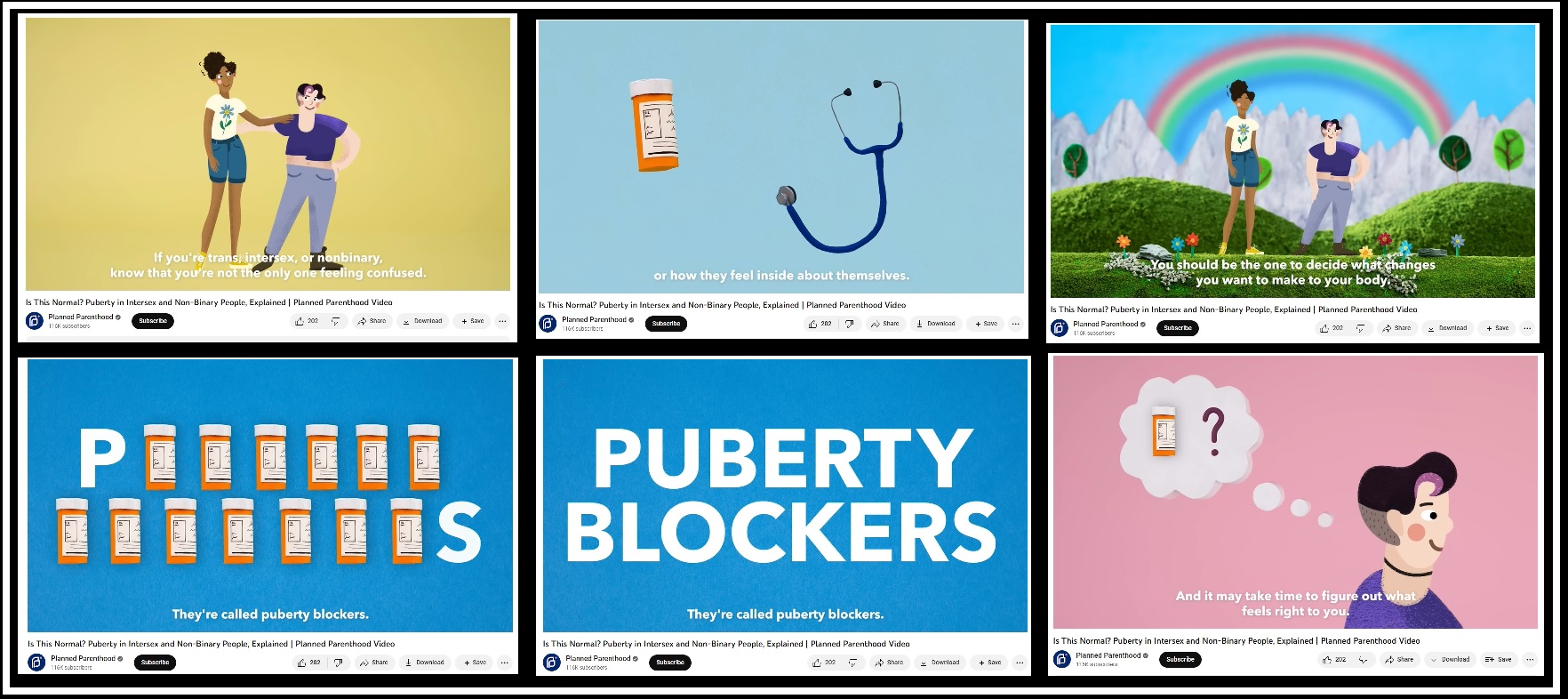
Planned Parenthood teen videos intersex nonbinary and trans vid promotes “puberty blockers”
In 2021, Abigail Shrier interviewed two transgender-identifying doctors who treat transgender-identified youth — Dr. Marci Bowers, a world-renowned vaginoplasty specialist who operated on reality-television star Jazz Jennings; and Erica Anderson, a clinical psychologist at the University of California San Francisco’s Child and Adolescent Gender Clinic.
“Both are board members of the World Professional Association for Transgender Health (WPATH), the organization that sets the standards worldwide for transgender medical care. And both are transgender women,” Shrier claimed.
Shrier wrote, “When I asked Anderson if she believes that psychological effects of puberty blockers are reversible, she said: ‘I’m not sure.’ When asked whether children in the early stages of puberty should be put on blockers, Bowers said: ‘I’m not a fan.'”
“When I asked Bowers if she still thought puberty blockers were a good idea, from a surgical perspective, she said: ‘This is typical of medicine. We zig and then we zag, and I think maybe we zigged a little too far to the left in some cases.’ She added, ‘I think there was naivete on the part of pediatric endocrinologists who were proponents of early [puberty] blockade thinking that just this magic can happen, that surgeons can do anything,’” Shrier also claimed.
Hormone Therapy and Children
Data compiled by Komodo [Health] for Reuters claimed that “At least 14,726 minors started hormone treatment with a prior gender dysphoria diagnosis from 2017 through 2021,” according to Reuters.
“Hormones are taken in a variety of ways: injections, pills, patches and gels… Hormone treatment may leave an adolescent infertile, especially if the child also took puberty blockers at an early age. That and other potential side effects are not well-studied, experts say,” noted Reuters.
Data shown by Reuters also indicated that adolescents placed on so-called “hormone therapy” increased well over 286% from 1,905 in 2017 to 4,231 in 2021.
Planned Parenthood (a top provider of “gender-affirming care”) is cashing in on the proliferation of transgender confusion including “hormone replacement therapy (HRT).” Likewise, abortion facilities, which often fail to specify age limits for HRT on their websites, are also openly advertising the service to minors.
Planned Parenthood clients claim that the organization does little to no counseling before prescribing cross-sex hormones or referring clients for permanent, body-altering surgery. But so far, Planned Parenthood appears to only provide hormone injections to minors at a limited number of affiliates.
Still, the organization, which normalizes changing gender anytime you ‘feel’ like it, is willing to refer minors for life-altering drugs and may even have plans to expand its targeting of teens. A brochure uploaded by the Virginia League for Planned Parenthood affiliate claims to serve “patients 16 & older for HRT, with the hope to serve younger patients in the future.” (emphasis added)
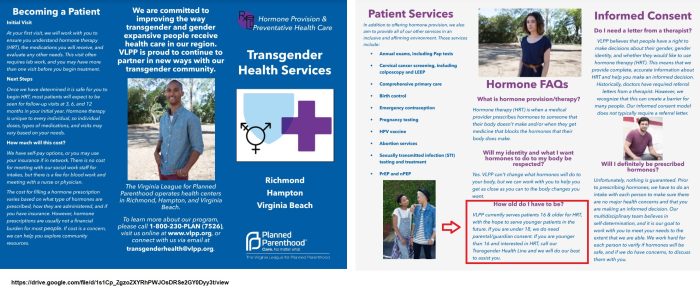
Virginia League for Planned Parenthood transgender brochure
Planned Parenthood’s website claims that these hormones, which include “testosterone cypionate, estradiol cypionate, and estradiol valerate” can be “administered through self-injection.”
“There are two types of self-injections: intramuscular (IM) injections and subcutaneous (SubQ) injections,” the Planned Parenthood website states.
Planned Parenthood of South, East, and North Florida’s website tells clients that the “cost for a [gender affirming hormone therapy] GAHT visit is between $95 to $105. In addition, lab test averages $26 to $142.”
Gender Surgeries
Komodo Health’s analysis of insurance claims for Reuters uncovered “56 genital surgeries among patients ages 13 to 17 with a prior gender dysphoria diagnosis from 2019 to 2021.”
Reuters noted that “Among teens, ‘top surgery’ to remove breasts is more common. In the three years ending in 2021, at least 776 mastectomies were performed in the United States on patients ages 13 to 17 with a gender dysphoria diagnosis,” they wrote. “This tally does not include procedures that were paid for out of pocket.”
A separate analysis published by JAMA looked at data from 2016 to 2020 for so-called gender-affirming surgery (GAS). The study found that breast and chest procedures made up a greater percentage of the “surgical interventions” in younger patients, finding that “Among patients younger than 19 years, 3678 GAS procedures were performed.”
JAMA’s analysis claimed that surgical “interventions” generally were on the increase “likely due in part to federal and state laws requiring coverage of transition-related care, although actual insurance coverage of specific procedures is variable,” authors wrote. And, according to the New York Times (NYT) “The number of genital surgeries in particular increased with age, which researchers attributed to the higher complexity and ‘definitive nature’ of the procedure.”
“Gender-affirming surgery (GAS) in the U.S. nearly tripled from 2016 to 2019,” MedPage Today reported about the JAMA analysis. The number of procedures rose from 4,552 in 2016 to 13,011 in 2019. Surgeries “declined slightly to 12,818 in 2020” during the pandemic the analysis also showed.
The study found that from 2016 to 2019 about 48,000 patients underwent surgeries with the most common procedures being “breast and chest procedures, which occurred in 27187 patients (56.6%), followed by genital reconstruction (16 872 [35.1%]) and other facial and cosmetic procedures (6669 [13.9%]),” authors claimed.
Breast and chest procedures made up a “greater percentage of the surgical interventions in younger patients, while genital surgical procedures were greater in older patients,” the authors wrote.
“Overall, 25 099 patients (52.3%) were aged 19 to 30 years, 10 476 (21.8%) were aged 31 to 40, and 3678 (7.7%) were aged 12 to 18 years,” the analysis claimed.
The graph below also reveals that younger people (ages 12-18) received 3,215 top surgeries (ranging in price from $3,000 to $10,000) and 405 bottom surgeries (ranging in price from $6,000 to $150,000) during this time.
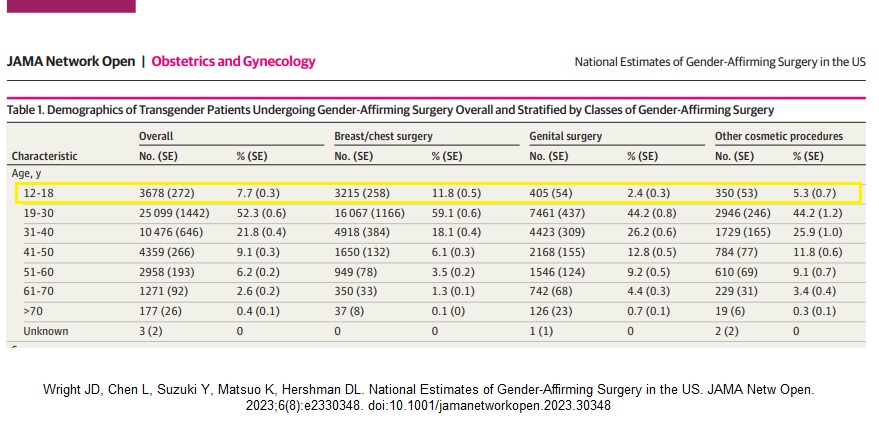
Transgender Surgeries by age 2016-2020 published by JAMA
While at this time, Planned Parenthood is not offering gender surgeries, the organization promotes it, advertises locations on their website (even to minors), and is willing to assist clients in obtaining these surgeries.
Countries Limit Transgender Treatments
Transgender confusion and the availability of body-altering “treatments” to minors might be expanding inside the U.S., but other countries are cracking down.
According to the NYT, “Finland has begun limiting who can access gender-related treatments and Sweden has restricted the use of puberty blockers and hormones to clinical trials. A Norwegian health body and the French National Academy of Medicine have also urged caution,” they reported.








